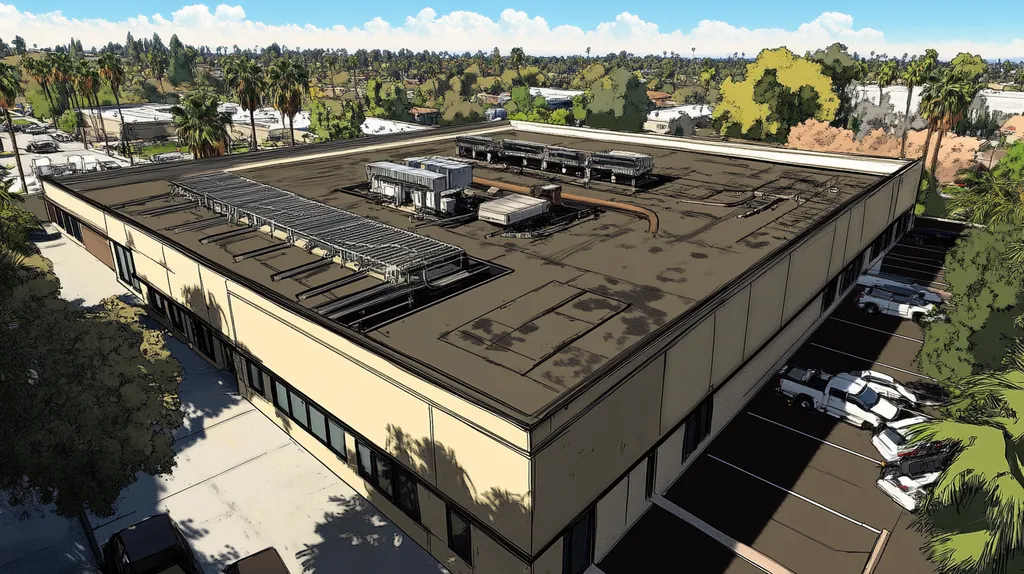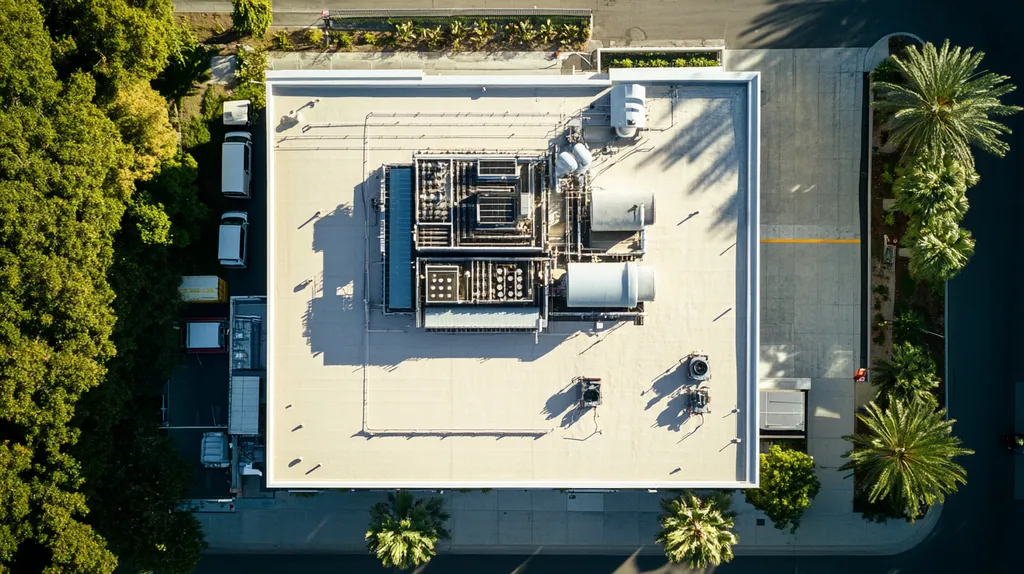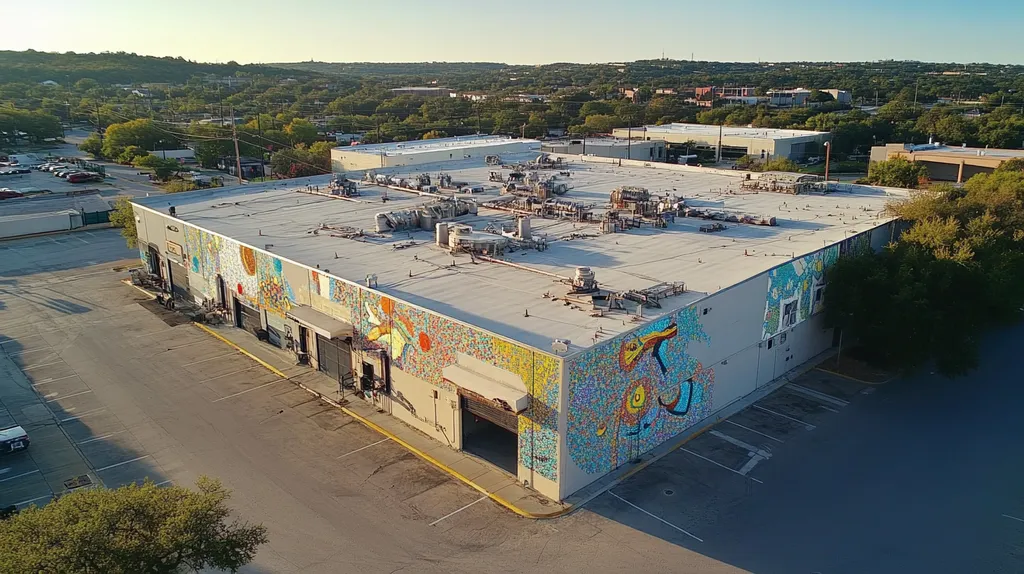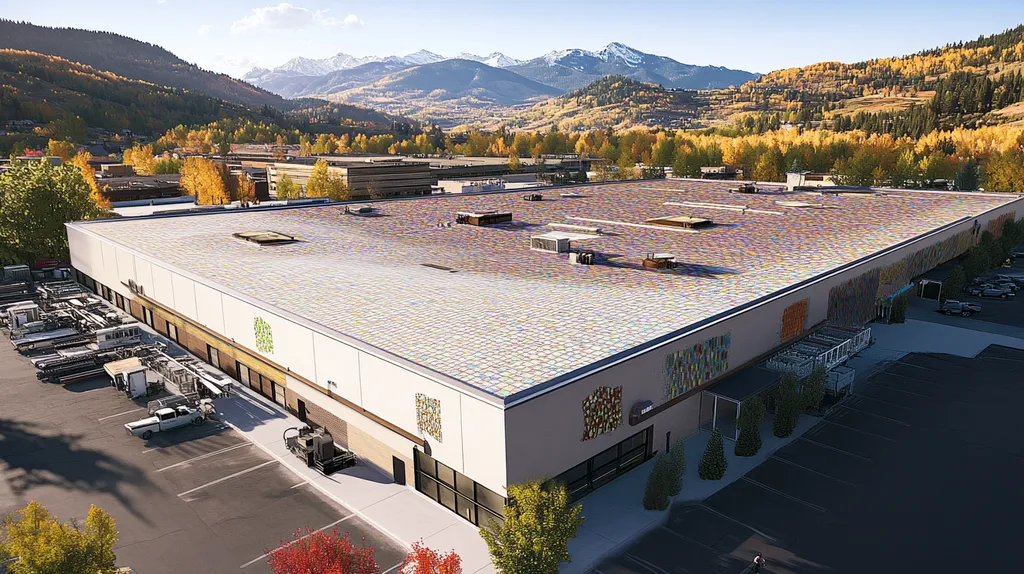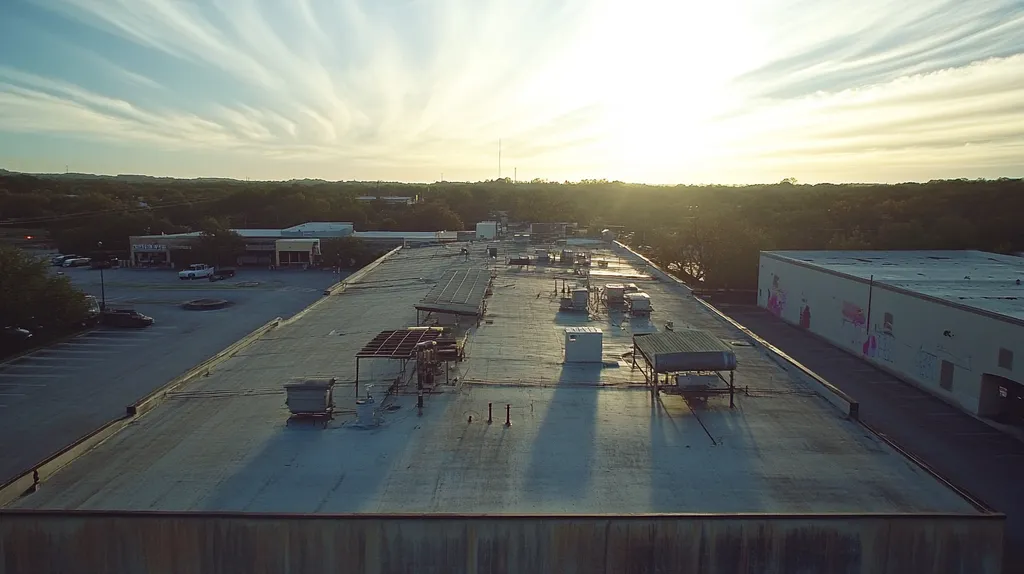Commercial roofing projects face a critical challenge: nearly 30% exceed their planned timelines, leading to significant operational disruptions and budget overruns. For facility managers, establishing realistic project timelines can mean the difference between seamless operations and costly delays.
Modern roofing projects must navigate complex factors including material availability, weather constraints, and evolving building codes. Without proper planning, these challenges can extend project durations by weeks or even months.
This comprehensive guide examines six essential components of roofing project timelines, from performance factors through long-term considerations, providing facility managers with actionable solutions for successful project execution.
SECTION 1: PERFORMANCE FACTORS
Establishing a project timeline for a commercial roof is essential for smooth facility operations and budget management. Delays can escalate costs and risk property damage or inventory loss. Alarmingly, research indicates that around 30% of roofing projects exceed their planned timeframes, disrupting business activities. Therefore, facility managers must grasp key performance factors to reduce risks and set achievable expectations. This section delves into the suitability of roofing materials, the impact of environmental conditions, and the intricacies of the project scope.
Assessing Roof Material Suitability and Durability
The choice of roofing material significantly impacts project timelines. Facility managers should evaluate factors such as climate, building purpose, and warranty options. For instance, while flat roofs may work well for warehouses, they can trap water if improperly designed, increasing the risk of leaks. Selecting robust materials like TPO or PVC can enhance longevity and reduce maintenance needs, contributing to a smoother project timeline.
Installation methods also play a crucial role. Some materials require specialized skills or equipment, affecting the availability of competent contractors. Facilities that neglect these considerations may encounter unforeseen delays. For example, choosing a less common roofing system might result in challenges securing immediate installation assistance.
Additionally, local material availability can affect timelines. Some roofing supplies may have extended lead times, leading to project delays. Therefore, proactive planning around material selection can help mitigate potential holdups, ensuring a more efficient roofing project.
Key Action Items
Evaluating Environmental and Weather Impacts on Timelines
Weather is a significant factor influencing roofing project timelines. Unforeseen weather events, such as rain or extreme temperatures, can halt construction, delaying completion. For instance, heavy rainfall during installation may jeopardize the integrity of certain roofing materials. By understanding local weather trends, facility managers can schedule work for optimal conditions.
Environmental considerations should also assess long-term durability. Roofs in areas prone to high winds or heavy snowfall need extra reinforcement, which may extend project timelines. Being proactive about these challenges can create a buffer against delays and reduce costs down the line.
Lastly, seasonal conditions should inform scheduling decisions. Roofing projects are generally more feasible during drier months. Factoring in these environmental variables at the outset enables facility managers to establish realistic timelines and minimize operational disruptions.
Key Action Items
Analyzing Project Scope and Site Complexity
The scope of the roofing project greatly affects its timeline. Larger facilities or those requiring significant structural alterations will naturally take longer than basic replacements. Understanding these project intricacies from the start is vital for effective scheduling. For example, a multi-level roof may require different approaches and resources, influencing the overall timeline.
Site complexity can pose additional challenges. A roof surrounded by uneven terrain or existing mechanical equipment may require established access routes for workers and materials, leading to longer timelines due to heightened labor and logistical demands.
Engaging a qualified contractor early can significantly improve timeline accuracy. Their expert insight can identify potential site-related issues ahead of time, facilitating more precise project planning. Addressing these complexities during initial discussions enables facility managers to execute the project smoothly.
Key Action Items
SECTION 2: FINANCIAL CONSIDERATIONS
Navigating the financial aspects of a commercial roofing project is crucial, as poor budgeting can lead to hefty financial challenges. Industry estimates show that nearly 30% of roofing projects exceed their initial budgets due to unexpected factors. Facility managers must pay close attention to financial considerations affecting project timelines, including budget allocation, material costs, and contingency funding. This section highlights these essential components to empower informed decision-making and effective management.
Budget Allocation Aligned with Project Phases
A well-defined budget is key to successfully managing any roofing project. Facility managers should strategically allocate funds across different phases, such as assessment, design, and installation. This approach helps prevent unanticipated costs by ensuring there are adequate resources available as each phase progresses.
Often, facility managers may overlook the costs associated with initial assessments, leading to hasty choices that could compromise quality. Proper budget allocation fosters transparency and encourages dialogue among all parties involved, keeping the project aligned with expectations.
Creating a flexible budget that accommodates adjustments throughout the project reduces the likelihood of financial surprises. Setting aside contingency funds for unforeseen issues guarantees that financial pressures do not compromise the roofing system’s quality.
Key Action Items
Cost Impacts of Material Lead Times and Availability
Material availability directly affects the financial dynamics of a roofing project. Recent supply chain disruptions illustrate how shortages can lead to longer lead times and price increases. Facility managers must consider these aspects when crafting their budgets and timelines.
For instance, delays in ordering materials that are known to be in limited supply can lead to higher procurement costs. Understanding market dynamics allows facility managers to make better-informed choices about material sourcing.
Utilizing a “just-in-time” ordering strategy can help control costs while ensuring timely material delivery. However, this technique requires diligent oversight of inventory levels and supplier reliability. Identifying dependable suppliers can reduce the risks of delays and keep expenses in check.
Key Action Items
Funding Contingencies for Schedule Delays
Having a contingency plan is essential for managing financial risks linked to potential schedule setbacks. Unanticipated challenges, such as severe weather or permit delays, can significantly impact both project timelines and budgets. Facility managers need a proactive funding strategy to navigate these uncertainties and avoid added financial strain.
Designating a specific percentage of the overall budget for contingencies offers necessary liquidity to address unexpected delays. This financial cushion allows facility managers to respond promptly, minimizing disruptions to both the project timeline and budget.
Furthermore, fostering clear communication with contractors is critical. A strong working relationship can help pinpoint potential issues early and develop collaborative solutions, protecting financial resources from unforeseen challenges.
Key Action Items
SECTION 3: COMPLIANCE REQUIREMENTS
Complying with regulatory requirements is crucial in ensuring that roofing projects proceed without costly interruptions. Failing to secure necessary permits and approvals can lead to construction stoppages and financial penalties. Additionally, aligning with local building codes during the planning phase not only protects project integrity but also ensures that the roofing system remains safe and durable.
Securing Permits and Regulatory Approvals Early
Securing the right permits is foundational for any commercial roofing project. Local municipalities often impose strict regulations that necessitate specific approvals before work can commence. To avoid setbacks, facility managers should initiate the permit acquisition process well ahead of project start dates.
Consulting with local authorities to understand required permits can streamline the process and reduce the risk of delays. Often, projects may require multiple permits, adding layers of complexity that should be addressed proactively.
One instance involved a facility manager in California facing a two-month delay due to a missed environmental permit, resulting in both schedule and cost overruns. Working with an experienced roofing contractor can enhance the efficiency of obtaining these approvals.
Key Action Items
Scheduling Inspections to Minimize Project Interruptions
Inspections are critical checkpoints that ensure compliance during roofing projects. These assessments generally occur at significant phases, such as after deck preparation or prior to membrane application. Planning ahead for these inspections minimizes the likelihood of project delays.
Incorporating inspection dates into the project timeline can alleviate potential bottlenecks. Last-minute inspection requests can disrupt established workflows and extend timelines.
Moreover, it’s important to verify inspector availability on scheduled dates, especially in jurisdictions where resources may be limited. Conducting pre-inspection meetings with all stakeholders can clarify expectations and enhance communication.
Key Action Items
Ensuring Adherence to Local Building Codes and Standards
Understanding local building codes is essential for compliance in commercial roofing projects. These codes outline specific materials and techniques that must be followed to ensure safety and structural integrity. Non-compliance can lead to substantial penalties, including mandated rework.
Facility managers should familiarize themselves with current building codes relevant to their projects, as codes are frequently updated. Staying informed helps prevent delays stemming from outdated practices or materials.
For example, utilizing non-compliant materials can jeopardize project success and result in financial liabilities. Partnering with licensed professionals ensures adherence to these regulations throughout the roofing process.
Key Action Items
SECTION 4: RISK MANAGEMENT
Effective risk management is a cornerstone of successful commercial roofing projects. Ignoring potential risks can lead to costly delays and budget overruns, significantly impacting operations. Severe weather can disrupt timelines and threaten worker safety, while misalignment in contractor availability can prolong project completion. Facility managers must take a proactive approach to identify and mitigate these risks for timely, on-budget project execution.
Identifying Weather-Related Risks and Mitigation Plans
Weather poses substantial challenges in roofing projects, particularly in areas affected by storms, heavy rain, or extreme heat. Conditions such as these can halt work, delay material deliveries, and endanger worker safety. For example, a sudden storm can interrupt scheduled activities and damage sensitive materials left exposed.
To combat these challenges, facility managers should create a comprehensive weather mitigation plan. This includes scheduling work during typically favorable seasons, employing reliable weather forecasting tools, and developing contingency strategies for unforeseen weather events. Having these strategies embedded in the project timeline can prevent costly delays.
Additionally, safeguarding materials and securing the work site can minimize damage risks. Regular updates and communication with contractors regarding potential weather changes can also help the team stay prepared and agile.
Key Action Items
Coordinating Contractor Availability and Labor Risks
Contractor availability can be a critical factor that influences project timelines. When contractors are double-booked or unable to start when needed, it can cause significant delays and hamper progress. These scenarios can be particularly challenging during adverse weather, compounding the issue.
To mitigate these labor-related risks, facility managers should maintain open lines of communication with their roofing contractors. Understanding contractors’ schedules is essential to align project timelines effectively. Furthermore, engaging multiple contractors can offer flexibility, reducing the likelihood of bottlenecks.
Labor shortages or mismatched skill sets can also impede progress. It is essential to assess the capabilities of the contracting team before work begins. Having contingency plans, such as hiring temporary labor, is also recommended to counteract unforeseen labor shortages.
Key Action Items
Implementing Safety Protocols to Avoid Work Stoppages
Safety is paramount in roofing projects. Accidents or injuries can not only endanger workers but also result in significant project delays and increased costs. Therefore, it is crucial to establish and uphold stringent safety protocols throughout the project lifecycle.
Facility managers must collaborate closely with contractors to craft comprehensive safety plans that adhere to local regulations and industry standards. This includes organizing regular safety trainings, ensuring all personnel are equipped with the necessary safety gear, and maintaining clear communication regarding potential hazards on site.
Conducting regular safety audits can also help identify and resolve risks before they escalate into accidents. Preparing emergency protocols, such as designated first aid areas, is essential for minimizing disruptions and safeguarding personnel on site.
Key Action Items
SECTION 5: OPERATIONAL PROCEDURES
Establishing an effective project timeline for a commercial roof is critical to minimizing disruptions and avoiding costly delays. With nearly 30% of commercial roofing projects surpassing planned timeframes, facility managers must implement strong operational procedures. By developing a detailed project schedule, using organized checklists, and fostering clear communication, stakeholders can ensure a smoother project execution and higher quality outcomes.
Developing a Detailed Project Schedule with Milestones
A comprehensive project schedule forms the backbone of any roofing project. It outlines essential tasks and deadlines, facilitating timely decision-making. For instance, a well-structured timeline can include phases like pre-construction assessments, material procurement, and installation stages.
Incorporating milestones allows for more effective tracking of progress. Each milestone can signify critical checkpoints, such as the completion of tear-off or the installation of underlayment, making it easier to spot delays early and implement necessary corrections.
Leveraging technology can further enhance scheduling efficiency. Using construction management software enables facility managers to schedule tasks, allocate resources, and track real-time progress. Improved visibility into project status helps ensure timely deliveries and avoid bottlenecks.
Key Action Items
Utilizing Checklists and Documentation for Progress Tracking
Checklists and documentation are essential tools for maintaining project momentum. They facilitate systematic tracking of tasks and ensure that crucial steps aren’t missed. For instance, a checklist can outline key compliance requirements and inspection points throughout the roofing process.
A structured documentation process allows teams to easily record information regarding material deliveries and labor hours. This data is invaluable for analyzing project performance and making timely adjustments. Consistent documentation also provides a clear audit trail for any arising issues.
Furthermore, checklists enhance quality control by allowing teams to confirm that work meets established standards. Conducting daily or weekly review sessions based on these checklists ensures alignment and quick resolution of any issues.
Key Action Items
Communication Strategies for Stakeholders and Teams
Effective communication is vital for driving project success. A well-structured communication plan keeps all stakeholders informed and engaged throughout the project. Designating a primary point of contact helps streamline information flow and updates.
Regular meetings and progress reports play a crucial role in maintaining stakeholder engagement. By sharing updates with contractors and internal teams, potential challenges can be discussed, fostering collaboration towards solutions. This practice builds trust and a unified sense of purpose.
Additionally, leveraging various communication channels can enhance effectiveness. Email, text alerts, and project management platforms ensure that stakeholders receive critical information promptly, regardless of their location.
Key Action Items
SECTION 5: OPERATIONAL PROCEDURES
Establishing an effective project timeline for a commercial roof is critical to minimizing disruptions and avoiding costly delays. Alarmingly, nearly 30% of commercial roofing projects exceed their planned timeframes, emphasizing the need for facility managers to implement strong operational procedures. By creating a comprehensive project schedule, utilizing organized checklists, and promoting clear communication, stakeholders can ensure smoother project execution and higher quality outcomes.
Developing a Detailed Project Schedule with Milestones
A comprehensive project schedule forms the backbone of any roofing project. It outlines essential tasks, timelines, and milestones, facilitating timely decision-making. For example, a well-structured timeline will include key phases such as pre-construction assessments, material procurement, and installation stages.
Incorporating milestones allows for better tracking of project progress. Each milestone may represent critical checkpoints, such as the completion of the tear-off process or the installation of the underlayment, making it easier to identify delays early and take corrective action.
Leveraging technology can enhance scheduling efficiency. Utilizing construction management software helps in scheduling tasks, allocating resources, and tracking real-time progress. This visibility into the project’s status ensures timely deliveries and helps avoid bottlenecks.
Ultimately, a detailed project schedule not only organizes workflow but also instills confidence among stakeholders. With clear timelines and expected deliverables, accountability increases and overall performance improves.
Key Action Items
Utilizing Checklists and Documentation for Progress Tracking
Checklists and documentation are essential tools for maintaining project momentum. They facilitate systematic tracking of tasks and ensure that important steps are not overlooked. For instance, a checklist can outline key compliance requirements and inspection points throughout the roofing process.
A structured documentation process allows teams to easily record information regarding material deliveries and labor hours. This data is invaluable for analyzing project performance and making necessary adjustments. Consistent documentation also creates a clear audit trail in case issues arise.
Moreover, checklists enable effective quality control. Marking off completed tasks helps confirm that work meets established standards. Implementing daily or weekly review sessions based on these checklists is crucial for alignment and swift issue resolution.
Ultimately, a strong focus on checklists and documentation fosters a culture of transparency and accountability on the job site. This practice enhances efficiency and reduces the risk of unexpected delays.
Key Action Items
Communication Strategies for Stakeholders and Teams
Effective communication is essential for achieving project success. A well-structured communication plan keeps all stakeholders informed and engaged throughout the project. Facility managers should designate a primary point of contact to streamline information flow.
Regular meetings and progress reports are crucial for maintaining stakeholder engagement. By sharing updates with contractors, suppliers, and internal teams, stakeholders can collaboratively discuss challenges and solutions. This practice builds trust and fosters a unified sense of purpose.
Utilizing various communication channels can enhance effectiveness. Email, text alerts, and project management platforms ensure that stakeholders receive timely information. The right technology guarantees that all crucial updates reach stakeholders, regardless of their location.
In conclusion, robust communication strategies not only promote collaboration but also empower teams to address issues promptly. An informed team is better equipped to keep projects on track and uphold quality standards.
Key Action Items
The Bottom Line
With 30% of commercial roofing projects exceeding planned timelines, the stakes for proper project planning have never been higher.
Successful timeline management requires meticulous attention to performance factors, financial considerations, compliance requirements, risk management strategies, operational procedures, and long-term planning.
Facility managers who implement comprehensive project schedules, maintain detailed documentation, and establish clear communication protocols position themselves to avoid costly delays and disruptions.
The future of commercial roofing depends on integrating these critical timeline components while remaining adaptable to evolving industry standards and technological advancements.
By following the actionable solutions outlined in this guide, facility managers can significantly improve project outcomes and protect their roofing investments for years to come.
FREQUENTLY ASKED QUESTIONS
Q. What factors impact timelines for a commercial roof project?
A. Factors such as material suitability, weather impacts, and project scope significantly influence timelines. Proper evaluation allows for better planning and reduces the likelihood of delays, ultimately improving the efficiency of the project execution.
Q. How can financial considerations affect the timeline of a commercial roof?
A. Poorly managed budgets and unexpected costs can derail roofing projects. Ensuring proper funding allocation, setting aside contingency funds, and closely monitoring materials costs can maintain project timelines and prevent financial overruns.
Q. Why is securing permits early important for commercial roofing?
A. Early permit acquisition prevents costly delays caused by waiting for approvals. Understanding regulations upfront streamlines the process, allowing the project to progress on schedule without disruptions related to compliance issues.
Q. What risks should facility managers consider in roofing projects?
A. Facility managers should consider weather risks, contractor availability, and safety protocols. Proactively identifying and addressing these risks helps minimize delays and ensure project timelines remain on track while protecting workers and resources.
Q. What operational procedures can help manage a commercial roofing project?
A. Developing a detailed project schedule, using checklists, and promoting clear communication are key. These practices create accountability, minimize disruptions, and enable easier tracking of progress, contributing to overall project success.
Q. How can facility managers ensure smooth communication during roofing projects?
A. Establishing a communication plan and designating a primary contact is essential. Regular updates, scheduled meetings, and utilizing various communication channels keep all stakeholders informed and engaged throughout the project.
Q. What should facility managers do to validate contractor performance?
A. Regular evaluations of contractor performance, adherence to schedules, and quality of work are important practices. Seeking feedback and maintaining open lines of communication allow for timely adjustments and ensure alignment with project goals.

